ISSN ONLINE(2278-8875) PRINT (2320-3765)
ISSN ONLINE(2278-8875) PRINT (2320-3765)
| S. Yang Assistant professor, Dept. of EE and CS, CETPS, Alabama A & M University, Huntsville, Alabama, USA |
| Related article at Pubmed, Scholar Google |
Visit for more related articles at International Journal of Advanced Research in Electrical, Electronics and Instrumentation Engineering
A compact microwave bandstop filter (BSF) with high rejection is proposed. This filter combines a conventional two-open-stub BSF and an embedded open stub. Simulations show this filter has a wider and a deeper stopband without increasing circuit size, compared with the conventional BSF.
Keywords |
| Embedded Open Stub, Open Stub, Bandstop Filter. |
INTRODUCTION |
| Microwave bandstop filters (BSF) are being widely used in telecommunication systems. Various techniques have been developed to design and synthesis BSFs [1]. Conventionally, by cascading more open stubs onto a microstrip, one can obtain wider rejection bandwidth and a deeper rejection. The side effects are the high insertion loss in the passband and increased circuit size [2-3]. In this paper, a microstrip BSF with two open stubs and an embedded open stub is presented. By inserting an embedded open stub between the two open stubs of a conventional BSF, one can get a BSF with wider rejection bandwidth and deeper rejection without increasing the overall circuit size. The proposed BSF is simulated on Sonnet Suite 14.52. |
II. RELATED WORK |
| A conventional open-stub BSF can be formed by mounting two open stubs onto a microstrip. The length of the two stubs and the separation between the two stubs are a quarter of the wavelength at the midband frequency [2-3]. Embedded open-circuit stub was proposed by Shaman and Hong to generate a band notch on an ultra wide band bandpass filter [4]. An embedded open stub is realized by etching a U-shaped slot on a microstrip. Main dimensional parameters of an embedded open stub are its length, width, gap, and edge width. The band notch happens when the length of the embedded open stub equals to a quarter of the wavelength. In this paper, the proposed BSF is a combination of a conventional BSF and an embedded open stub. |
III. FILTER LAYOUTS AND SIMULATION RESULTS |
| Fig.1 shows the configuration of a conventional open-stub BSF. The length of the two open stubs and the separation between the two open stubs are a quarter of the wavelength at the midband frequency. The substrate material is Rogers TMM10i with a relative dielectric constant of 9.8 and a loss tangent of 0.002. The thickness of the substrate is 1.27 mm. The whole backside of the substrate is the ground plane. The width of the feed line and the open stubs is 1.2 mm, which gives a characteristic impedance of 50 Ohm. The two open stubs are 5.86 mm long and the separation between the centers of the two open stubs is also 5.86 mm. This conventional BSF is simulated on Sonnet Suite 14.52, and the results are shown in Fig. 2. The midband frequency is at 4.9 GHz, and the deepest rejection is more than -30 dB. |
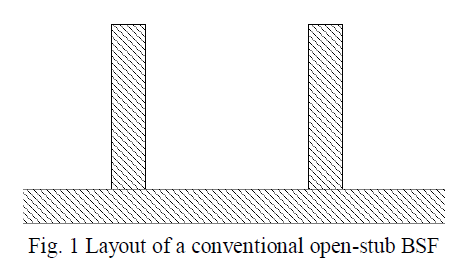 |
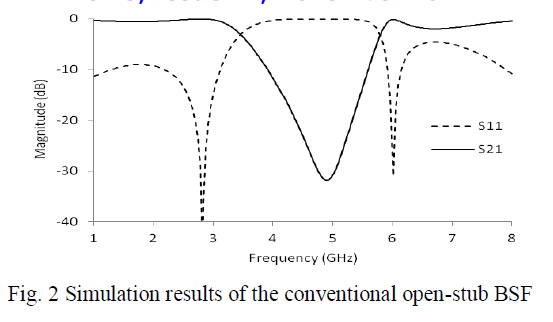 |
| An embedded open stub on the substrate mentioned early is shown in Fig. 3. The wide of the microstrip line is 1.2 mm. The width of the embedded stub is at 0.6 mm, and the gap is at 0.1 mm, and the width of the edge is at 0.2 mm. This embedded open stub is simulated at selected lengths on Sonnet Suite first, and results are shown in Fig. 4. The stopband center frequency decreases with embedded stub length, as expected. Secondly, the embedded stub is simulated at selected widths with a fixed length of 6 mm and a fixed gap of 0.1 mm, and simulation results show the stopband gets deeper and wider with larger stub width (Fig. 5). The stopband center frequency shifts down a little bit with larger embedded stub width. This should be caused by open end effect [5]. Wider stub has stronger open end effect, and hence larger equivalent extended stub length. Thirdly, the embedded open stub is simulated at two gaps with a fixed length of 6 mm and a fixed width of 0.6 mm. The stopband gets wider and deeper with larger gap and narrower edge (Fig. 6). |
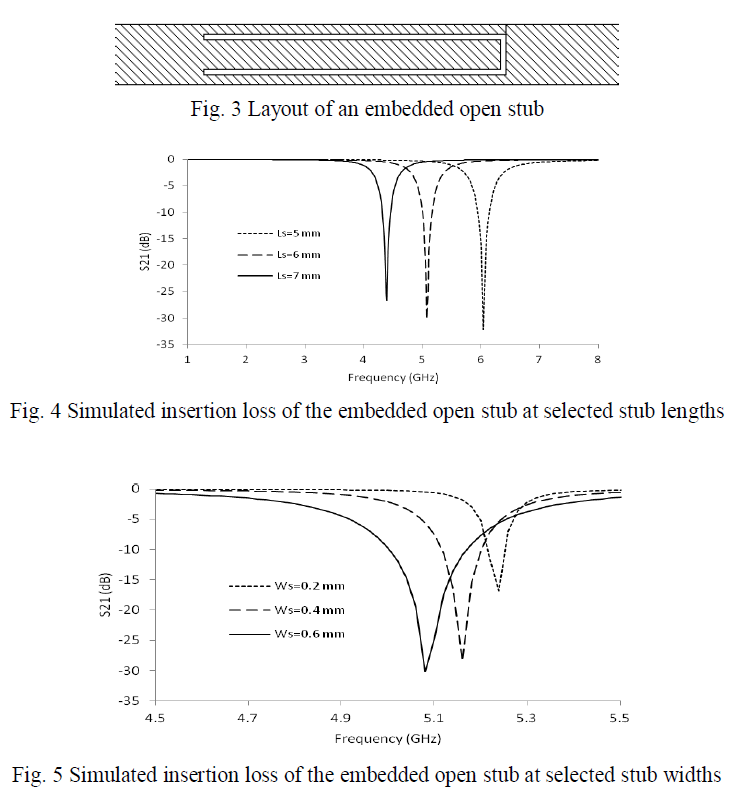 |
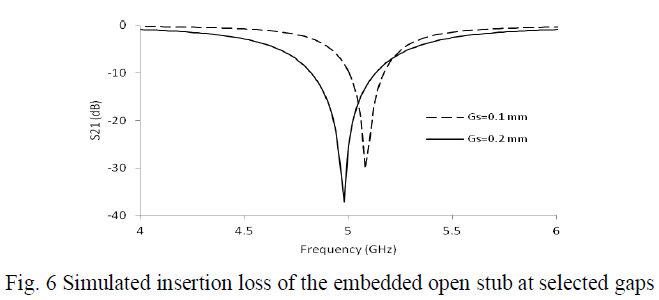 |
| The proposed BSF is a combination of the conventional two-open-stub BSF and an embedded open stub. Layout of this BSF is shown in Fig. 7. The width of the embedded open stub is chosen as 0.6 mm. The gap of the embedded open stub is at 0.1 mm. The edge width of the embedded open stub is at 0.2 mm. The length of embedded open stub was carefully tuned to 6.18 mm. The length of the two open stubs is tuned to 5.9 mm. The separation of the two open stubs is set to 6.28mm. The proposed BSF is simulated on Sonnet Suite, and the simulation results are shown in Fig. 8. The insertion losses of the proposed BSF and the conventional BSF are shown together in Fig. 9 for comparison. The stopband of the proposed BSF is wider and deeper compared with that of the conventional BSF. |
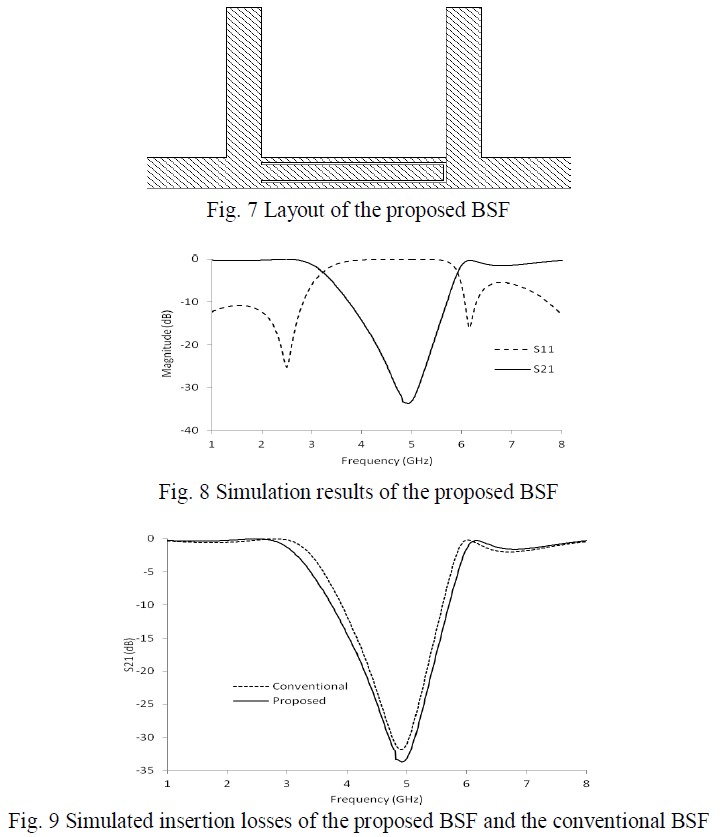 |
IV. CONCLUSIONS |
| An embedded open stub is inserted between the two open stubs of a conventional BSF to form a new BSF. The proposed BSF is simulated on Sonnet Suite software. Simulation results show the proposed BSF has a wider and deeper stopband compared with the conventional open-stub BSF. |
ACKNOWLEDGMENT |
| The author would like to thank Dr. Montgomery for his financial help, Dr. Scott for his help to install Sonnet Suite software, and Dr. Heidary for his microwave network analyzer. |
References |
|